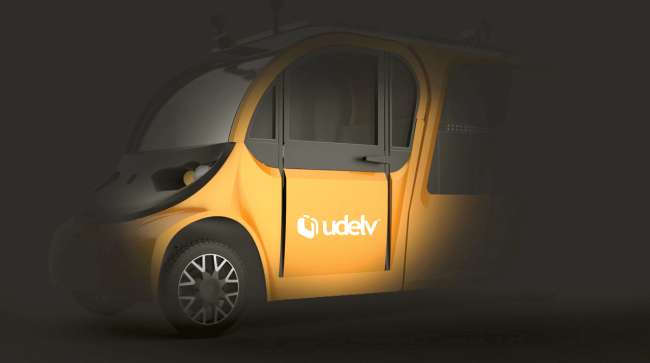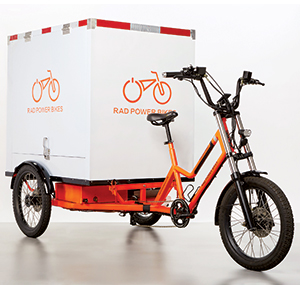New Vehicles Tackle Challenges of Urban E-Commerce

Two entrepreneurs are introducing an autonomous vehicle and electric cargo bike designed to reduce the costs arising from the last-mile delivery and returns of e-commerce merchandise in urban areas.
Burlingame, Calif.-based Udelv is launching this month an autonomous, electric-powered cargo vehicle designed for short deliveries and pickups.
Removing the driver with a commercial driver license will make the Udelv cheaper to operate. Its storage space could make it easier to return e-commerce purchases, a sector that has a return rate up to 30% of sales compared with about 11% for the entire retail sector, according to the National Retail Federation.
Merchants already are trying to address the returns issue. Amazon.com joined with Kohl’s Corp. to accept returns at 82 stores in Los Angeles and Chicago. And Wamart in November began its Mobile Express Returns program at 4,700 stores, where the consumer begins the return process through a smartphone app then takes it into the store.
The Udelv vehicle is somewhat of a mystery as the startup company won’t discuss basics such as the vehicle’s weight and size. Plans call for an official unveiling Jan. 30.

Laury
Udelv CEO Daniel Laury said the vehicle will drive itself but have a driver behind the wheel for the launch as required by California law. The vehicle will be overseen by a telecommunications command and control center as it travels. Consumers will interact with the merchant using a smartphone app.
The Udelv program requires consumers to come to the curb to pick up their groceries or package. The process will be the same for returns when consumer will be required to bring their package to the vehicle and place it in its cargo space, Laury said.
“There will be some adaptations by users on both sides to make this work,” he said. But this “will decrease consumer inconvenience and significantly reduce costs for retailers.”
Laury said that Udelv will give consumers a two-hour window to meet the vehicle. And many consumers seeking to return goods will prefer to interact with an autonomous vehicle instead of driving to the post office or UPS store.
Laury said Udelv has received interest from delivery firms, shippers and retailers. In the near term, he sees such merchants as grocery, food, pharmacy and caterers as users of the vehicle.
Also, electric bike manufacturer Rad Power Bikes has fashioned its RadBurro cargo-carrying tricycle.

Rad Power Bikes
The RadBurro can carry up to 700 pounds, cover a range of 40 to 80 miles on a single charge and costs $5,499, compared with the $25,000 cost of a delivery van, according to Rad Power. It costs about $1 for a full day’s charge in the Seattle area.
“There is a tremendous market need for last-mile transportation and fulfillment alternatives due to the explosion of e-commerce, the rise of urban centers, and the ever increasing demand for same-day deliveries to high-density residential areas,” said Rad Power CEO Mike Radenbaugh.
Seattle-based Rad Power estimates the total cost of ownership of a RadBurro over five years at $13,624 when adding up the trike purchase, insurance, and maintenance. That compares with $64,125 for a delivery van over five years.
UPS Inc. is testing a similar three-wheeled cargo trike from Truck Trike in Fort Lauderdale, Fla., and Pittsburgh, and completed a test in Portland, Ore., in 2015, said Tom Madrecki, director of urban innovation and mobility. Madrecki declined to share results of the Portland test but said the trike can be cheaper than delivery vans in certain neighborhoods.

Goodchild
A recent study from the Supply Chain Transportation and Logistics Center (SCTL) at the University of Washington found that challenges for trikes are “smaller cargo capacity, slower speeds, and severe weather conditions,” according to Measuring the Cost Trade-offs Between Electric-Assist Cargo Bikes and Delivery Trucks in Dense Urban Areas.
The competitive advantage of an electric trike is contingent upon the distance it must travel from depot to neighborhood, number of stops, the distance between stops, and number of parcels per stop, according to the study.
“The question is whether (the trike) can use bike lanes and can they park at the curb or on the sidewalk. If they just use the road or park like a regular delivery truck then there’s no improvement,” said Anne Goodchild, SCTL director and study co-author.
Goodchild notes that delivery methods evolve and that these two new companies, if successful, will join a host of options.
“Many ask , ‘When will everything be delivered by drone?’ That’s not going to happen,” Goodchild said. “These delivery alternatives will be added to the mix of (delivery) products we use.”




